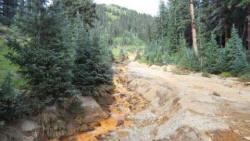|
 Wastewater
spill from Colorado gold mine triples in volume: EPA Wastewater
spill from Colorado gold mine triples in volume: EPA
 Send a link to a friend
Send a link to a friend
[August 10, 2015]
By Steve Gorman
(Reuters) - Some 3 million gallons of
toxic wastewater, triple previous estimates, have poured from a defunct
Colorado gold mine into local streams since a team of Environmental
Protection Agency workers accidentally triggered the spill last week,
EPA officials said on Sunday.
|
|
 The discharge, containing high concentrations of heavy metals such
as arsenic, mercury and lead, was continuing to flow at the rate of
500 gallons per minute on Sunday, four days after the spill began at
the Gold King Mine, the EPA said. The discharge, containing high concentrations of heavy metals such
as arsenic, mercury and lead, was continuing to flow at the rate of
500 gallons per minute on Sunday, four days after the spill began at
the Gold King Mine, the EPA said.
An unspecified number of residents living downstream of the spill
who draw their drinking supplies from their private wells have
reported water discoloration, but there has been no immediate
evidence of harm to human health, livestock or wildlife, EPA
officials told reporters in a telephone conference call.
Still, residents were advised to avoid drinking or bathing in water
drawn from wells in the vicinity, and the government was arranging
to supply water to homes and businesses in need.
The spill began on Wednesday after an EPA inspection team was called
to the abandoned mine near the town of Silverton in southwestern
Colorado to examine previously existing wastewater seepage.
 As workers excavated loose debris at the site, they inadvertently
breached the wall of a mine tunnel, unleashing a flow of the
orange-tinged slurry that cascaded into Cement Creek and then into
the Animas River downstream.
The town of Durango, Colorado, roughly 50 miles south of the spill
site, shut off its intakes of river water as a precaution, according
to the EPA.
By Friday, the main plume of the spill had traveled some 75 miles
south to the New Mexico border, prompting utilities in the towns of
Aztec and Farmington to shut off their intakes from the Animas as
well, local authorities said.
Agency officials said they were consulting with representatives of
the Navajo Nation, whose sprawling reservation borders Farmington
and the San Juan River, which is fed by the Animas River and has
also been tainted by the spill.
[to top of second column] |

EPA previously estimated 1 million gallons of wastewater had been
released since Wednesday, but on Sunday the agency revised that up
to 3 million gallons, based on measurements taken at a U.S.
Geological Survey stream gauge.
In recent days, EPA has been diverting the ongoing release into two
newly built settling ponds where the waste was being treated with
chemicals to lower its acidity and to filter out dissolved solids
before being discharged to Cement Creek.
The creek's water quality has already been badly degraded from a
long history of acid mine drainage in the area, agency officials
said.
Preliminary water sampling from the creek and Animas River showed
that concentrations of heavy metals briefly spiked in areas reached
by the wastewater plume but appeared to clear considerably once it
had passed downstream, EPA regional Administrator Shaun McGrath
said.
EPA officials said that by Sunday, a delineated "leading edge" of
the contamination flow was no longer visible from aerial surveys,
indicating concentrations of wastewater were diminishing.
(Reporting by Steve Gorman from Los Angeles; Editing by Chris Reese)
[© 2015 Thomson Reuters. All rights
reserved.]
Copyright 2015 Reuters. All rights reserved. This material may not be published,
broadcast, rewritten or redistributed.
 |